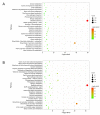Identification of High Tolerance to Jujube Witches' Broom in Indian Jujube (Ziziphus mauritiana Lam.) and Mining Differentially Expressed Genes Related to the Tolerance through Transcriptome Analysis
- PMID: 37299062
- PMCID: PMC10255488
- DOI: 10.3390/plants12112082
Identification of High Tolerance to Jujube Witches' Broom in Indian Jujube (Ziziphus mauritiana Lam.) and Mining Differentially Expressed Genes Related to the Tolerance through Transcriptome Analysis
Abstract
The jujube witches' broom (JWB) disease is a severe threat to jujube trees, with only a few cultivars being genuinely tolerant or resistant to phytoplasma. The defense mechanism of jujube trees against phytoplasma is still unclear. In this study, we aimed to investigate the tolerance mechanism of Indian jujube 'Cuimi' to JWB and identify the key genes that contribute to JWB high tolerance. Based on the symptoms and phytoplasma concentrations after infection, we confirmed the high tolerance of 'Cuimi' to JWB. Comparative transcriptome analysis was subsequently performed between 'Cuimi' and 'Huping', a susceptible cultivar of Chinese jujube. Unique gene ontology (GO) terms were identified in 'Cuimi', such as protein ubiquitination, cell wall biogenesis, cell surface receptor signaling pathway, oxylipin biosynthetic process, and transcription factor activity. These terms may relate to the normal development and growth of 'Cuimi' under phytoplasma infection. We identified 194 differential expressed genes related to JWB high tolerance, involved in various processes, such as reactive oxygen species (ROS), Ca2+ sensors, protein kinases, transcription factors (TFs), lignin, and hormones. Calmodulin-like (CML) genes were significantly down-regulated in infected 'Cuimi'. We speculated that the CML gene may act as a negative regulatory factor related to JWB high tolerance. Additionally, the cinnamoyl-CoA reductase-like SNL6 gene was significantly up-regulated in infected 'Cuimi', which may cause lignin deposition, limit the growth of phytoplasma, and mediate immune response of 'Cuimi' to phytoplasma. Overall, this study provides insights into the contribution of key genes to the high tolerance of JWB in Indian jujube 'Cuimi'.
Keywords: high-tolerant cultivar; jujube witches’ broom; key genes; phytoplasma concentrations.
Conflict of interest statement
The authors declare no conflict of interest.
Figures






Similar articles
-
Transcriptome profiling analysis revealed co-regulation of multiple pathways in jujube during infection by 'Candidatus Phytoplasma ziziphi'.Gene. 2018 Jul 30;665:82-95. doi: 10.1016/j.gene.2018.04.070. Epub 2018 Apr 27. Gene. 2018. PMID: 29709641
-
The Crosstalk of the Salicylic Acid and Jasmonic Acid Signaling Pathways Contributed to Different Resistance to Phytoplasma Infection Between the Two Genotypes in Chinese Jujube.Front Microbiol. 2022 Mar 18;13:800762. doi: 10.3389/fmicb.2022.800762. eCollection 2022. Front Microbiol. 2022. PMID: 35369447 Free PMC article.
-
Molecular Identification of a New Phytoplasma Strain Associated with the First Observation of Jujube Witches'-Broom Disease in Northeastern China.Plant Dis. 2007 Oct;91(10):1364. doi: 10.1094/PDIS-91-10-1364B. Plant Dis. 2007. PMID: 30780544
-
Indian jujube a potential fruit tree to improve the livelihood.Saudi J Biol Sci. 2023 Sep;30(9):103769. doi: 10.1016/j.sjbs.2023.103769. Epub 2023 Aug 5. Saudi J Biol Sci. 2023. PMID: 37609543 Free PMC article. Review.
-
Chinee Apple (Ziziphus mauritiana): A Comprehensive Review of Its Weediness, Ecological Impacts and Management Approaches.Plants (Basel). 2023 Sep 8;12(18):3213. doi: 10.3390/plants12183213. Plants (Basel). 2023. PMID: 37765379 Free PMC article. Review.
Cited by
-
Genome-Wide Identification of Xyloglucan Endotransglucosylase/Hydrolase Multigene Family in Chinese Jujube (Ziziphus jujuba) and Their Expression Patterns Under Different Environmental Stresses.Plants (Basel). 2024 Dec 15;13(24):3503. doi: 10.3390/plants13243503. Plants (Basel). 2024. PMID: 39771201 Free PMC article.
-
A newly identified glycosyltransferase AsRCOM provides resistance to purple curl leaf disease in agave.BMC Genomics. 2023 Nov 7;24(1):669. doi: 10.1186/s12864-023-09700-y. BMC Genomics. 2023. PMID: 37936069 Free PMC article.
References
-
- Jung H.Y., Sawayanagi T., Kakizawa S., Nishigawa H., Wei W., Oshima K., Miyata S.I., Ugaki M., Hibi T., Namba S. ‘Candidatus Phytoplasma ziziphi’, a novel phytoplasma taxon associated with jujube witches’-broom disease. Int. J. Syst. Evol. Microbiol. 2003;53:1037–1041. doi: 10.1099/ijs.0.02393-0. - DOI - PubMed
-
- Liu M.J., Zhao Z.H. Germplasm Resources and Production of Jujube in China. Acta Hortic. 2009;840:25–32. doi: 10.17660/ActaHortic.2009.840.1. - DOI
-
- Tian G.Z., Zhang Z.S., Li Z.Q., Guo J.H. Dynamic of Jujube Witches’ Broom Disease and Factors of Great Influence at Ecologically Different Regions in China. Sci. Silvae Sin. 2002;38:83–91.
-
- Bertaccini A., Duduk B., Paltrinieri S., Contaldo N. Phytoplasmas and Phytoplasma Diseases: A Severe Threat to Agriculture. Am. J. Plant. Sci. 2014;5:1763–1788. doi: 10.4236/ajps.2014.512191. - DOI
Grants and funding
- 2022YFD2200404/National Key Research and Development Program of China
- 2022XACX1100/Hebei Province Academy of Sciences Key Cooperative Unit, research on jujube witches' broom disease pathogen, rhizosphere microorganisms, the interactions and pathogenic mechanisms with jujubes, National XA Science and Technology innovation project
LinkOut - more resources
Full Text Sources
Miscellaneous

